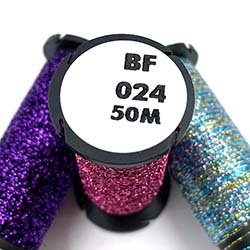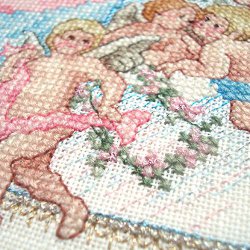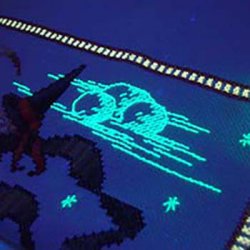Blending Filament
Thin, tinsel-like fiber that adds just a whisper of effect to any design. This creates more visual interest and makes designs more eye-catching or realistic. Available in metallic, holographic, vintage, hi lustre, and glow-in-the-dark colors. Supremely versatile, it can be added to any yarn or floss to dress up a design—even used in hair extensions and braids to add color and light.
-
How to use Blending Filament
Applications:
Blackwork, crewel, crochet, cross stitch/counted thread, doll making (by hand and machine), fly fishing, hardanger, knitting (by hand), lace making, machine embroidery/bobbin work, machine embroidery/in the needle, miniatures, needlepoint/canvas work, punch embroidery, silk gauze/Polysil embroidery, smocking, stumpwork, weaving, and many more.
Hand Embroidery:
The thin quality of Blending Filament allows you to create elements of subtle light reflection. It is often combined with cotton, wool or another thread type, in the same needle, to create a random metallic sparkle. The addition of one or two strands does not add weight to your thread, so you can use the needle size that accommodates the stranded cotton. Vary the amount of highlight or shimmer you want to add to a design by using one or more strands; use a single strand for the most subtlety or two strands for added effect.
Overstitching & Texture:There's more to Blending Filament than just 'blending,' however. You can also use Blending Filament by itself to overstitch, bringing a reflective highlight or glow to a particular spot. Also, use a single strand of Blending Filament by itself in half-cross stitches for backgrounds on fabric; it creates a slight texture and subtle shimmer.
Tips on using Kreinik Blending Filament in hand work:
- Use short lengths of thread — about 45cm (18 inches) or less — to avoid excessive abrasion when pulling the thread through the ground fabric or canvas. The more a strand is pulled through fabric or canvas, the more 'wear' it causes on the thread. Using shorter lengths will maintain the quality of the thread, plus reduce tangling as shorter lengths are easier to control (less knotting!). If you are stitching on fabric, use a needle large enough to 'open' the hole in the fabric sufficiently and allow the thread(s) to go through more easily; this reduces friction and fraying.
- If combining Blending Filament with another thread type in a needle, you may wish to moisten the filament together with the other thread with a slightly damp, soft cosmetic sponge. This can help to control both thread types as they work together in your needle.
- Stitch slowly with Blending Filament to achieve more control and uniformity in stitching.
- Let your needle hang frequently to let the thread untwist and thus reduce knotting.
- If using Hi Lustre Blending Filament, lay the filament flat and smooth as you stitch to allow maximum light reflection. Think of it as a tiny ribbon; using a laying tool can help prevent twisting, or simply use your finger to lay the thread.
Machine Embroidery:
Blending Filament creates three-dimensional effects whether used in the needle or the bobbin of a sewing machine with specific embroidery patterns or free-motion techniques. It is ideal for art quilts and wearable art. Blending Filament also creates delicate reflective highlights in programmed patterns on embroidery machines. Kreinik offers an extensive color range to match fabric or mood.
Tips on using Kreinik Blending Filament with a sewing machine or serger:- When using Blending Filament in the needle, try a Metalfil or Metallica needle. You will need to loosen the top tension and adjust the bottom tension; practice until you get a combination that works with your machine, stitches, and fabric choice.
- When using Blending Filament in the bobbin for needle lace or other effects, experiment with different tension settings until you find a combination that achieves the look you want on your fabric. A 50m reel of Blending Filament fills a bobbin nicely.
- You can also combine Blending Filament with other threads or use it alone in a serger. Estimate 10 times the length to be sewn for thread yardage when using without mixing with other threads.
Care:
Kreinik Blending Filament is hand or machine washable and dry cleanable. Cool water is recommended. Do not use bleach. It can also be tumble-dried on low setting. When ironing a finished piece containing Blending Filament, do not iron directly on the thread; use a cloth, and do not use steam.
-
Blending Filament Threading Technique
Since this is a thin, tinsel-like thread, knot Blending Filament onto your needle for greater control, whether you are using Blending Filament alone or combined with another thread type in one needle. Note: This technique can also be used with Kreinik Cable, Cord, Ombre & Japan Thread #1.First, cut the required length of Blending Filament and fold about 2 inches (5 cm) from one end.Insert the loop through the eye of the needle and pull the loop over the needle's point.
Tighten the loop at the end of the eye to secure the thread to the needle.
Gently stroke the knotted thread once to 'lock' in place.
Note: when using two strands of Blending Filament, cut double your required length, fold in half, and pass the center (loop) through the eye of the needle and over its point.
-
Secrets of Blending Filament revealed!
Blending Filament is a one-of-a-kind thread that gives you a unique effect in your stitching. "There is nothing that can add more sparkle and pizzazz to your cross stitch than blending filament," says stitcher Bonnie Morrow. The hint of metallic adds light, interest and a 3-D effect. Is your project looking dull or flat? Blending Filament adds visual flavor without being over-the-top, just like a little spice adds flavor to your cooking.
One myth about Blending Filament is that it's difficult to use. While it may seem crazy to stitch with something akin to Christmas tree tinsel, the truth is that when you follow a few steps, it's not so hard. After all, a little time and effort IS worth the amazing results, whether you're starting a diet, crocheting an afghan, constructing a building, or adding sparkle to a stitched angel.
If you don't know how to use Blending Filament or if you get frustrated while using it, read on. Just a few tips will put the *sparkle * in your eyes.
5 Truths about Blending Filament
- It is actually two threads: the metallic part, and a thin string wound "within" the metallic that lends support. You may notice these two threads at the end of your Blending Filament, where they separate slightly. Any "frayed" ends can be hidden into your stitches as you start and stop, or clipped off once your starting point is secured. If the separation bothers you, use a product called Fray Check to seal the end.
- You CAN stitch with Blending Filament without the core string. Officially, we don't recommend it because it can make the filament prone to static and breaking. However, stitchers and designers tell us they occasionally remove the core from the flatter Hi Lustre colors and just take extra care to reduce static and breaking. So if the core REALLY bothers you, carefully separate it from the metallic and proceed with stitching.
- It is made of a different material than cotton floss. It may sound obvious, but sometimes we expect all thread types to behave the same way — and most of us hate to slow down. Blending Filament has a different consistency and thus requires more patience. You cannot stitch as quickly with it as you can cotton floss because of the slippery-ness of the metallic material. That's the nature of the unique filament. If it continuously slips off your needle while you're stitching, knot it to the needle.
- It's a delicate material, which is why some stitchers may find that it snaps or stretches. Blending Filament is a thin polyester material with slight elasticity. It is not as strong as silk. If your filament breaks or stretches while you are stitching, just adjust your tension (relax). This applies whether you are using Blending Filament for hand or machine embroidery.
- If you prefer, you can use Blending Filament by itself, rather than combined with cotton floss in one needle. Blending Filament was designed to be combined with another thread type; that is what produces the random metallic effect in a design. However, if you don't like stitching with two different threads at once, then don't. Simply stitch your area in one type first (like cotton floss), then overstitch with Blending Filament by itself. It may sound like double work, but actually this is the easiest way to control the filament, control how much highlight or shimmer you want in your design, and control exactly where you want it. This way, you're the one in control, not the thread.
10 Things you May Not Know About Blending Filament
- How do you get it started? The thread end is secured in a notch in the spool. Unwind the thread from the notch to start, and when you're done, secure the end in the notch again.
- How do you control it? Stitch slowly and use short lengths, which are easier to manage.
- Why did the designer call for it? It adds a SUBTLE metallic shimmer that makes a design more realistic or interesting. Use it in a design to replicate anything shiny in nature, or to add a HINT of whimsy, visual interest, and "bling."
- Is Balger the same as Blending Filament? "Balger" was the name Kreinik used when it started manufacturing threads in the 1970s. We've gone beyond Blending Filament with many thread types now, so we use distinct names, like Very Fine #4 Braid. Blending Filament refers to our thinnest, tinsel- or cord-like metallic threads.
- How many colors? Blending Filament comes in basic metallic, glow-in-the-dark, vintage, corded, and hi lustre colors. The hi lustre and vintage versions are flat for maximum light exposure. All together, we have over 100 Blending Filament colors available to you and designers.
- Blending Filament can be affected by humidity. Is your climate very dry? Then your filament may have more static in it as you stitch. Some stitchers recommend using a product called Thread Heaven, or a slightly damp cosmetic sponge, to "tame" flyaway filament.
- Don't try to use more than 2 strands of Blending Filament in one needle. There's just no need to. If you want a bolder metallic look, simply move up to a thicker thread, like Very Fine #4 Braid. Braid is used by itself rather than combined with another thread type in one needle.
- It's not just for cross stitch and needlepoint. Its thinness and blending qualities make it useful in tatting, crochet, knitting, crazy quilting, fly fishing, collage art, even stitching on paper.
- It's ideal for punchneedle. Use Blending Filament by itself in a 1-strand needle, or 1 strand of Blending Filament + 1 strand of cotton or silk floss in a 3-strand needle.
- Blending Filament is sold worldwide. From Australia to Alaska, South Africa to Saskatchewan and everywhere in between, Blending Filament is used by creative people everywhere. Kreinik has a US and international Store Locator listing on www.kreinik.com.







